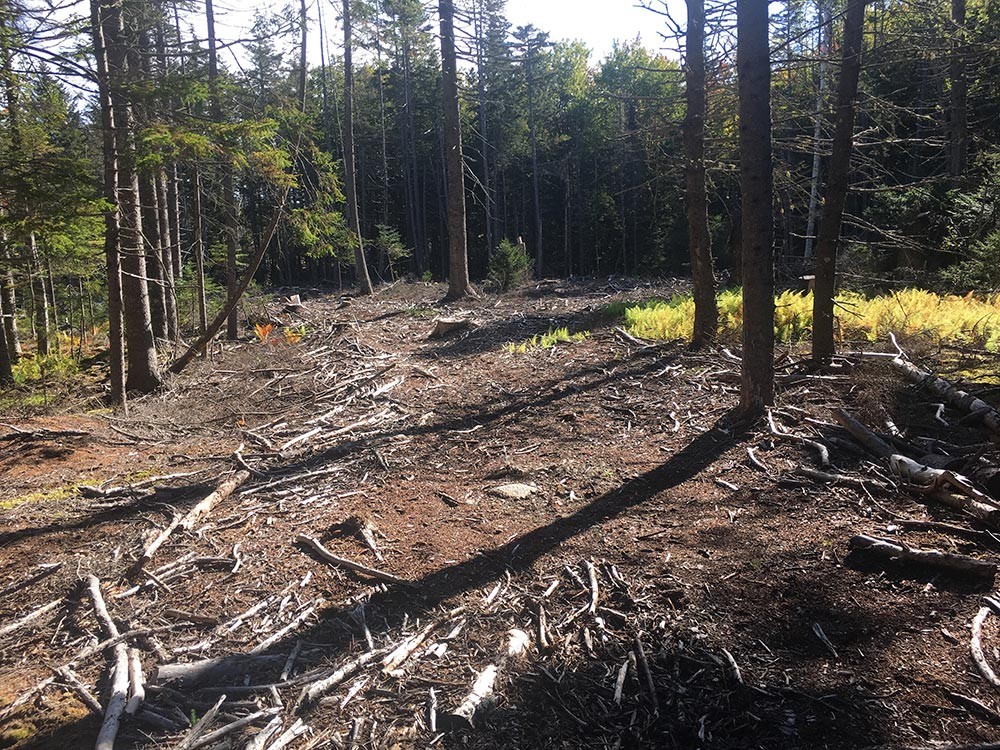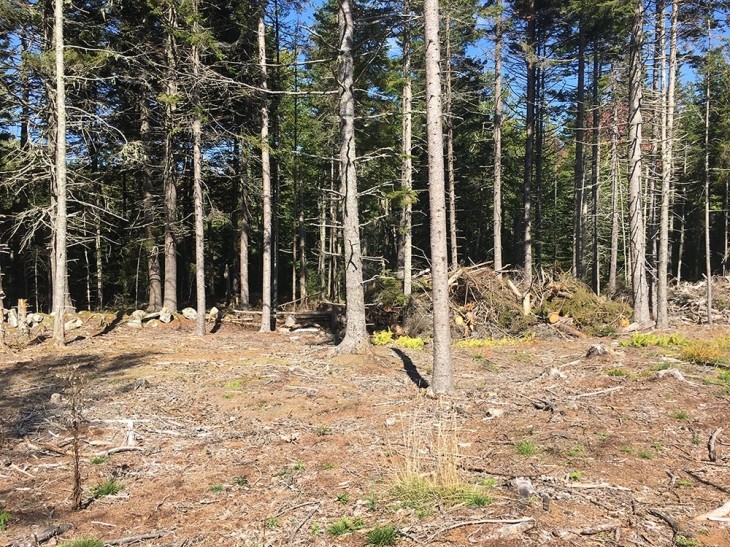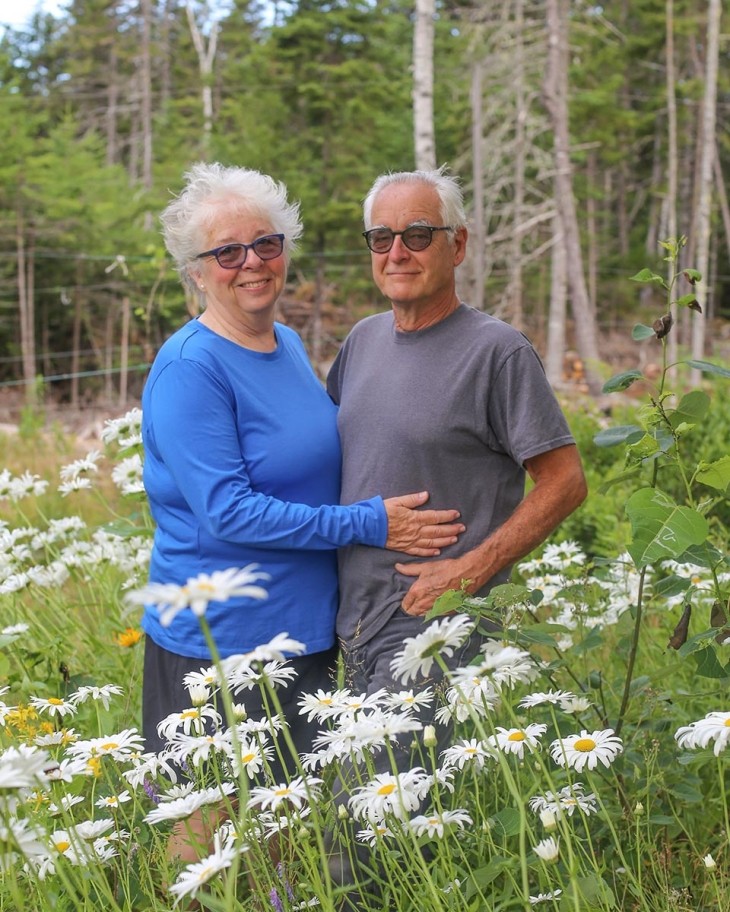
With pantlegs stuffed into our boots to ward off ticks, my wife Kathryn and I trudged after Si Balch, our licensed forester, straight into a spruce thicket next to our house. The going was tough. Much of the standing timber was so tightly packed we could barely slip through. We had to thread our way over, around, and through a jumble of fallen branches, twigs, often entire uprooted trees. It was as though someone had played a giant game of pick-up sticks, except no one had bothered to pick up.
But Si Was undaunted by the condition of our woodlot. As we walked, he pointed out marketable timber over here, dead stuff with no value over there, and up ahead, deciduous species that should be protected. Although most trees were spruce, he identified some red maple, oak, and white and yellow birch. We paused in a mucky area thick with skunk cabbage. “We won’t clear this spot,” he said, one hand on a frail balsam fir, “and we’ll leave a buffer around it.” He waved his hand toward the east. “Clear out that clutter and you’ll have your meadow.”
Wetland protection, habitat creation, and triage for trees. That sounded good to me.
We were traipsing through a portion of our 10-acre woods located on Deer Isle, a 38-square-mile rocky island off the Maine coast. Photographs of the island taken during the 1800s depict a severely cut-over landscape. That is likely when our property was last cleared and a crude stone wall was built along its northern and eastern boundary.
When Kathryn first saw this land in the early 1970s, it was blanketed with red and white spruce – some trees sapling-sized, others full grown. She, along with her sister and a friend, decided to build a house in a tiny clearing on the northeastern portion. First, they hauled out more than 20 garbage bags stuffed with beer cans and rum bottles. Then they opened up the clearing to make room for a 648-square-foot Shelter-Kit cottage. The pre-cut package cost $10,000 in 1978 and included all lumber, windows, doors, screens, hardware, and even ladders and hand tools. It took them three weeks to erect the basic structure. Kathryn planted highbush blueberries and rhubarb behind the cottage and established a vegetable garden and orchard nearby.
I first saw the land six months after Kathryn and I became a couple, in the late 1990s. Immediately I was enchanted by the forest, its solitude, and the potential for gardening. But by then, spruce had begun to shade out the gardens and encroach on the cottage. When I retired in 2013 from my position as university teacher and an aquatic biologist for the federal government, some of the older spruces were beginning to fall. Likely they were stressed by their high density, disease, and the thin, rocky soil. By then, the cottage had been expanded several times. We were afraid the trees would fall and damage the house or serve as fuel for forest fires.
One day, the owner of 20 acres adjacent to our land told us she planned to hire a logger to clear out some spruce. I realized this could be an opportunity to get our trees taken out by a professional. But turning our property over to a logger made me nervous. Although we wanted clearings for wildflowers, birds, and small mammals, we also wanted to be good stewards of our land. Suppose the logger buried the wetlands, took out the hardwoods, obliterated the moss-covered stone wall?
I contacted our neighbor’s forester, Si Balch (a member of the Northern Woodlands board of directors), and that’s when we went on a walk together through our woods. He listened to our concerns and our desire to create openings for wildlife. He started by describing logging equipment, methods, and how the work would be accomplished. Si explained that our rocky, nutrient-poor soil didn’t allow for deep root systems, and if the forest were “thinned,” trees left standing could topple during storms. He assured us we could clear small patches and avoid wet areas. Later, he took us to recently logged areas so we could better understand the process.
It turns out that having our small acreage logged in conjunction with a neighbor’s was advantageous. Si found three logging companies interested in working the combined 30 acres. Two were large forestry management organizations that used mechanized harvesters. The third was a local operator, Tobey Woodward, who with his wife, Maya, cut with a chainsaw and twitched out logs with a cable skidder. I couldn’t imagine the much larger mechanized equipment operating so close to our house, so I called Tobey.
As he and I stepped over logs and pushed through brush, I asked a bevy of questions: “Can you take out trees close to the house without damaging the blueberries?” “Will you avoid the hardwoods and leave dead snags for woodpeckers?” “Can you scrape branches into piles for wildlife?”
Yes, yes, and yes – he could do all that. When Tobey and Maya started working together, she drove the skidder, but now she does most of the cutting. “I just hated all those levers,” she said. Tobey follows behind in the skidder, pulling logs to the staging area. They work together in the woods three days a week; the other two, she stays home with their pre-school-age daughter.
Si marked trees for cutting, designated areas to be protected, and estimated stumpage. In the winter of 2018 and 2019, Tobey and Maya cut, hauled out, and sold over 1,000 red and white spruce trees (approximately 60,000 board feet was removed in total). Most of our marketable timber came from six small patches along the Woodwards’ skid road. They also took trees from a 50-foot swath that surrounded the house and gardens. When they finished on our property, they started on our neighbor’s land. A single logging road now meanders through both properties and connects all the clearings, each less than an acre in size.
Tobey used the skidder blade to scrape up slash near our house, on the 50-foot strip surrounding the house and gardens, and on a single cleared area near the driveway. He pushed the scrapings into a series of four- to six-foot-high windrows, creating a clear area of easy walking around the house and a place to plant wildflowers. Kathryn and I scattered wildflower seeds, including milkweed for monarch butterflies, to speed recolonization. At Si’s suggestion, I’ll protect some deciduous sprouts with tree tubes. The other areas, still covered with slash, will regenerate naturally.
Less than half of our 10 acres was cleared. Wetlands and the stone wall, areas without marketable timber, were not touched. The cost of creating brush piles and cutting next to the house was defrayed by our portion of the timber revenue. By working together with our neighbor, we created a management plan for both properties that has small- and large-scale benefits. Not only did we increase biological and habitat diversity on both of our properties, we enhanced the overall value of the island ecosystem.
After two years, portions of the scraped areas are awash with color: goldenrod, silverrod, hawkweed, bracken ferns, purple asters, black-eyed Susans, clusters of red maple shoots. I only wish more logging roads meandered through the spruce forests on this island, connecting and creating old fields, meadows, and small stands of hardwoods. We’ve come a long way from the widespread cutovers of the nineteenth and early twentieth centuries, and we’ve seen just how dramatically common-sense woodland management can improve even a small parcel like ours.




